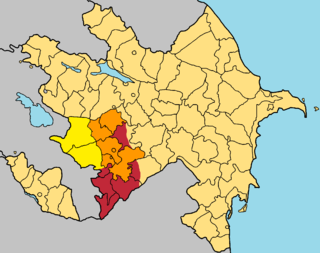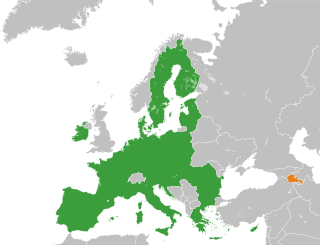Related Research Articles

Artsakh, officially the Republic of Artsakh or the Republic of Nagorno-Karabakh, was a breakaway state in the South Caucasus whose territory was internationally recognised as part of Azerbaijan. Between 1991 and 2023, Artsakh controlled parts of the former Nagorno-Karabakh Autonomous Oblast of the Azerbaijani Soviet Socialist Republic, including its capital Stepanakert. It had been an enclave within Azerbaijan from the 2020 Nagorno-Karabakh war until the 2023 Azerbaijani offensive, when the Azerbaijani military took control over the remaining territory controlled by Artsakh. Its only overland access route to Armenia after the 2020 war was via the five kilometres (3.1 mi)–wide Lachin corridor, which was placed under the supervision of Russian peacekeeping forces.
The OSCE Minsk Group was created in 1992 by the Conference on Security and Cooperation in Europe (CSCE), now Organization for Security and Co-operation in Europe (OSCE), to encourage a peaceful, negotiated resolution to the conflict between Azerbaijan and Armenia over Nagorno-Karabakh.

The 2008 Mardakert clashes began on March 4 after the 2008 Armenian election protests. It involved the heaviest fighting between ethnic Armenian and Azerbaijani forces over the disputed region of Nagorno-Karabakh since the 1994 ceasefire after the First Nagorno-Karabakh War.
This page lists in alphabetical order articles related to the Republic of Artsakh and Nagorno-Karabakh region. For a topically arranged list of articles, please see Outline of the Republic of Artsakh.

Armenia and Serbia maintain diplomatic relations established between Armenia and the Federal Republic of Yugoslavia on 14 January 1993. Both countries are members of the United Nations, Council of Europe, Organization for Security and Co-operation in Europe, NATO's Partnership for Peace, the International Monetary Fund, and the International Bank for Reconstruction and Development.

The Bishkek Protocol was a provisional ceasefire agreement, signed by the representatives of Armenia, Azerbaijan, the unrecognized Republic of Artsakh, and Russia on May 5, 1994, in Bishkek, the capital of Kyrgyzstan.
The Zheleznovodsk Communiqué, also known as the Zheleznovodsk Declaration or Zheleznovodsk Accords, is the joint peace communiqué mediated by Russian President, Boris Yeltsin and Kazakh President, Nursultan Nazarbayev in Zheleznovodsk, Russia on September 23, 1991, with an intention to end the three-year-long hostilities between Armenia and Azerbaijan over the Nagorno-Karabakh region, still an autonomous oblast of the Azerbaijan SSR. Although consensus was reached, the treaty was never ratified.
The Tehran Communiqué, also known as the Joint statement of the heads of state in Tehran is the joint communiqué mediated by Iranian President, Akbar Hashemi Rafsanjani and signed by the acting President of Azerbaijan, Yagub Mammadov and President of Armenia, Levon Ter-Petrossian on May 7, 1992 with an intention to end the four-year-long hostilities between Armenia and Azerbaijan over the Nagorno-Karabakh region, a former autonomous oblast of the Azerbaijan SSR.

The Madrid Principles were proposed peace settlements of the Nagorno-Karabakh conflict, proposed by the OSCE Minsk Group. The OSCE Minsk Group was the only internationally agreed body to mediate the negotiations for the peaceful resolution of the conflict prior to the renewed outbreak of hostilities in 2020. Senior Armenian and Azerbaijani officials had agreed on some of the proposed principles but made little or no progress towards the withdrawal of Armenian forces from occupied territories or towards the modalities of the decision on the future Nagorno-Karabakh status.

United Nations General Assembly Resolution 62/243, titled "The Situation in the Occupied Territories of Azerbaijan", is a resolution of the United Nations General Assembly about the situation in Nagorno-Karabakh, which was adopted on March 14, 2008 at the 62nd session of the General Assembly. It became the seventh United Nations document concerning Nagorno-Karabakh and the third and last United Nations General Assembly document on it.
The Baker rules refer to a set of negotiation process principles identifying who the parties to the Nagorno-Karabakh conflict are. Armenia and Azerbaijan are identified as the principal parties and the Armenian community and Azerbaijani community of Karabakh are identified as interested parties.
Council of Europe Parliamentary Assembly (PACE) Resolution 1416 (2005), titled “The conflict over the Nagorno-Karabakh region dealt with by the OSCE Minsk Conference”, is a resolution of PACE about the situation on occupied territories currently in the possession of Azerbaijan by Armenian military forces, adopted by PACE on January 25, 2005.

The political status of Nagorno-Karabakh remained unresolved from its declaration of independence on 10 December 1991 to its September 2023 collapse. During Soviet times, it had been an ethnic Armenian autonomous oblast of the Azerbaijan Soviet Socialist Republic. Following the dissolution of the Soviet Union, a conflict arose between local Armenians who sought to have Nagorno-Karabakh join Armenia and local Azerbaijanis who opposed this.

The Zurich Protocols refer to two bilateral protocols signed in 2009 by Armenia and Turkey that envisioned starting the process of normalizing relations between the two countries. The Protocols included provisions for the establishment of formal diplomatic relations, the opening of the Turkish-Armenian border, and the establishment of a joint historical commission on the Armenian genocide issue. The agreement, which later proved to be ineffectual, had been brokered by the United States, Russia and France.

The 2016 Nagorno-Karabakh conflict, also known as the Four-Day War, April War, or April clashes, began along the former Nagorno-Karabakh line of contact on 1 April 2016 with the Artsakh Defence Army, backed by the Armenian Armed Forces, on one side and the Azerbaijani Armed Forces on the other.

Relations between Azerbaijan and the Organization for Security and Cooperation in Europe (OSCE) began when Azerbaijan joined OSCE’s predecessor, the Conference on Security and Cooperation in Europe (CSCE), on January 30, 1992. This was the first European organization Azerbaijan joined. The CSCE transformed into the OSCE shortly afterwards in 1995.
During its existence, the Republic of Artsakh and the United States did not have official diplomatic relations as the United States was among the vast majority of countries that did not recognize Artsakh as a sovereign nation and instead recognized the region of Artsakh, or Nagorno-Karabakh, as part of Azerbaijan. Despite no formal relations, the Republic of Artsakh had a representative office in Washington, D.C. since November 1997. It is not known whether the office still functions after the apparent dissolution of Artsakh.

The European Union Monitoring Capacity to Armenia (EUMCAP) was a European Union civilian deployment in the territory of Armenia that was agreed on 6 October 2022 and officially became operational on 20 October 2022. The EUMCAP completed its mandate on 19 December 2022 at which point it was superseded by a European Union Planning Assistance Team in Armenia in preparation of a possible longer-term mission in the country.

An OSCE Needs Assessment Team in Armenia was deployed by the Organization for Security and Co-operation in Europe (OSCE) in the territory of Armenia between 21 and 27 October 2022 following the Armenia–Azerbaijan border crisis.

Armenia–OSCE relations began when Armenia joined the OSCE's predecessor, the Conference on Security and Cooperation in Europe (CSCE), on 30 January 1992. The CSCE transformed into the Organization for Security and Co-operation in Europe (OSCE) shortly afterwards in 1995.
References
- ↑ "Personal representatives of Armenian and Azeri Presidents hold Nagorno-Karabakh talks in Prague - OSCE". osce.org .
- ↑ Department Of State. The Office of Electronic Information, Bureau of Public Affairs. "The United States and Nagorno-Karabakh". 2001-2009.state.gov.
- ↑ Tracey German. "Untangling the Karabakh Knot". Conflict Studies Research Centre, June 2005
- ↑ Benjamin A. T. Graham. "Nagorno-Karabakh in Limbo". Middle East Quarterly. Retrieved 2010-12-01.